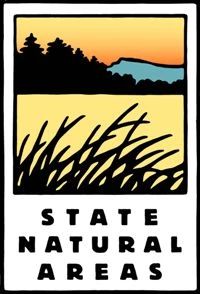Grand Island
No. 687

Grand Island is a mosaic of northern dry-mesic forest, floodplain forest, and open wetlands. Natural origin white and red pine dominate the dry-mesic forest with quaking aspen, northern red oak, and balsam fir also present. Dominant trees are generally 12-24 inches in diameter with some greater than 28 inches. Canopy diversity, size, and age distribution are moderate to good. The sub-canopy is predominantly red maple and white spruce with significant amounts of pines. Embedded in the forest are scattered bedrock outcrops with varying amounts of tree cover depending on the soil depth.
Canopy trees include a mix of red oak, red maple, white pine, and ironwood. More open areas have a mix of dry prairie and barren vegetation with species such as poverty oat grass, harebell, pale corydalis, cow wheat, wild bergamot, and rusty woodsia. Dry 20-25 foot cliffs are present in several spots. The tall shrub layer is variable with hazelnut as the dominant species. The ground flora is moderately diverse with characteristic species including bracken fern, Penn sedge, and hog-peanut. Shrubs include blueberries, hazelnut, and bush honeysuckle.
The floodplain forest is dominated by large silver maple with green ash. The ground flora is of low diversity and likely due to the dense canopy and intermittent flooding. Ostrich fern, wood nettle and stinging nettle dominate. Sloughs and old stream channels are found throughout the island. Several rare and uncommon birds have been documented during breeding bird surveys. Grand Island is owned by the DNR and was designated a State Natural Area in 2017.
Very few State Natural Areas have public facilities, but nearly all are open for a variety of recreational activities as indicated below. Generally, there are no picnic areas, restrooms, or other developments. Parking lots or designated parking areas are noted on individual SNA pages and maps. If a developed trail is present, it will normally be noted on the SNA map and/or under the Maps tab. A compass and topographic map or a GPS unit are useful tools for exploring larger, isolated SNAs.
The good majority of SNAs are isolated and have few or no facilities. Some SNAs have vehicle access lanes or parking lots, but their accessibility may vary depending on weather conditions. Parking lots and lanes are not plowed during winter. Hiking trails may be nonexistent or consist of undeveloped footpaths. A GPS unit or compass and a detailed topographic map are useful tools for exploring larger SNAs.
Entrance fees: Except for Parfrey's Glen, the Cambrian Outlook in the Dells of the Wisconsin River, SNAs within State Parks and some within State Forests, all other DNR-owned SNAs do not have any admission fees. For more information, see Wis. Admin. Code NR 45 [exit DNR]. For non-DNR-owned SNAs, we are unaware of any vehicle or admission fees. However, please contact the landowner for more information.
Allowable activities: DNR-owned land
The activities listed below are generally allowed on all DNR-owned SNA lands. Exceptions to this list of public uses, such as SNAs closed to hunting, are noted above and posted with signs on the property site.
- Hiking
- Fishing
- Cross country skiing
- Hunting
- Trapping
- Scientific research (permit required [PDF])
- Outdoor education
- Wild edibles (What is this?)
- Pets (Rules)
- Wildlife viewing
Prohibited activities: all SNAs
Although a handful of sites allow activities like primitive camping (e.g. Lower Chippewa River on sand bars) or horseback riding (e.g. S. Kettle Moraine), the activities listed below are generally prohibited on DNR-owned SNAs.
- Camping and campfires
- Collecting of animals (other than legally harvested species), non-edible fungi, rocks, minerals, fossils, archaeological artifacts, soil, downed wood, or any other natural material, alive or dead.
- Collecting for scientific research requires a permit issued by the DNR
- Collecting of plants including seeds, roots or other non-edible parts of herbaceous plants such as wildflowers or grasses
- Drones: Flying-related activities, including the use of drones, hang-gliders and model airplanes, are prohibited. Permission may be issued by the SNA Program for the use of drones for educational or research purposes
- Geocaching
- Horseback riding
- Rock climbing
- Vehicles, including bicycles, ATVs, aircraft, and snowmobiles except on trails and roadways designated for their use.
For rules governing state-owned SNAs and other state lands, please consult Chapter NR 45 Wis. Admin. Code [exit DNR].
Location
Within the Menominee River State Recreation Area, Marinette County. T37N-R21E, Sections 13, 24. T37N-R22E, Sections 18, 19. 270 acres.
Driving directions
The island is accessible from the Menominee River. A public carry-in canoe access is located south of the SNA off Pemene Dam Road. A public boat ramp is located north of the SNA off Rattie Road.
The DNR's state natural areas program is comprised of lands owned by the state, private conservation organizations, municipalities, other governmental agencies, educational institutions and private individuals. While the majority of SNAs are open to the public, access may vary according to individual ownership policies. Public use restrictions may apply due to public safety, or to protect endangered or threatened species or unique natural features. Lands may be temporarily closed due to specific management activities.
Users are encouraged to contact the landowner for more specific details. The data shown on these maps have been obtained from various sources, and are of varying age, reliability, and resolution. The data may contain errors or omissions and should not be interpreted as a legal representation of legal ownership boundaries. To create your custom map where you can zoom to a specific location, please use the DNR's Mapping Application.
Grand Island is owned by: Wisconsin DNR
Management objectives and prescriptions
- Read the Menominee River Recreation Area Master Plan [PDF] for details.
